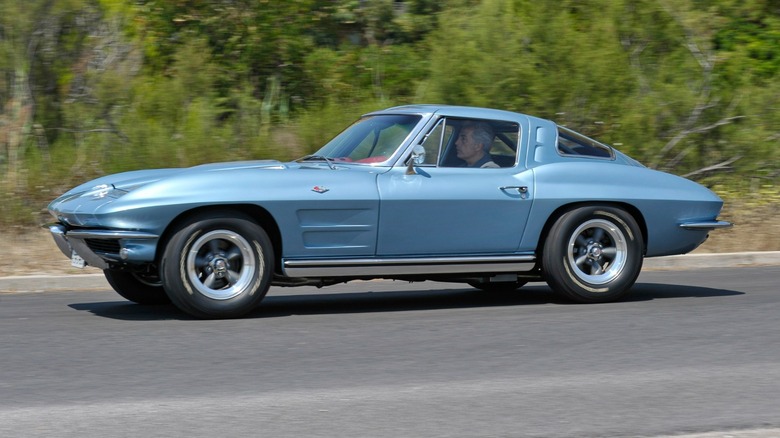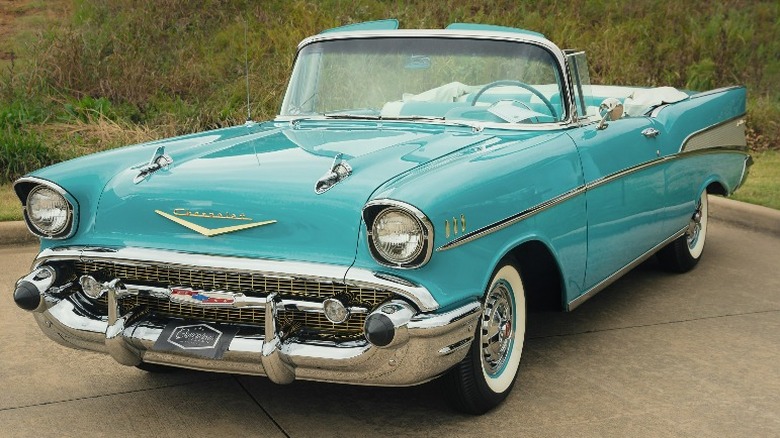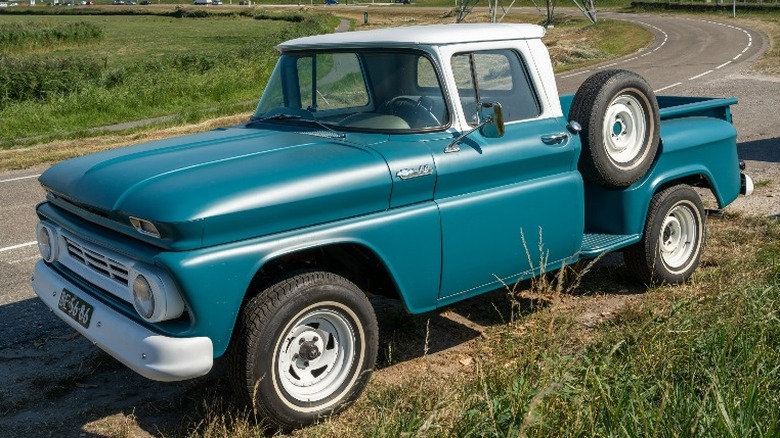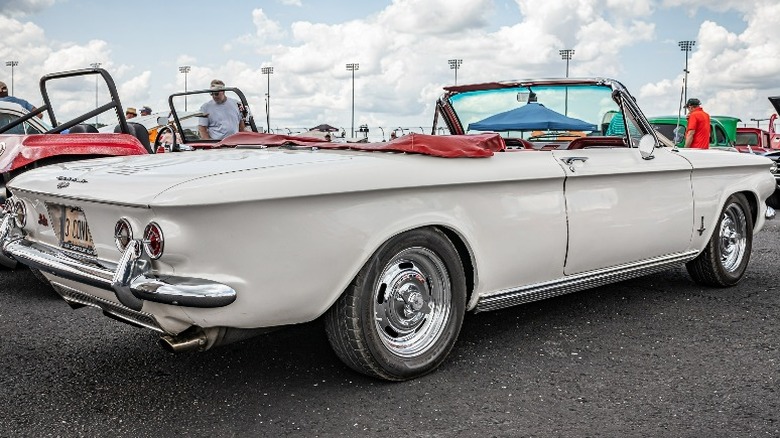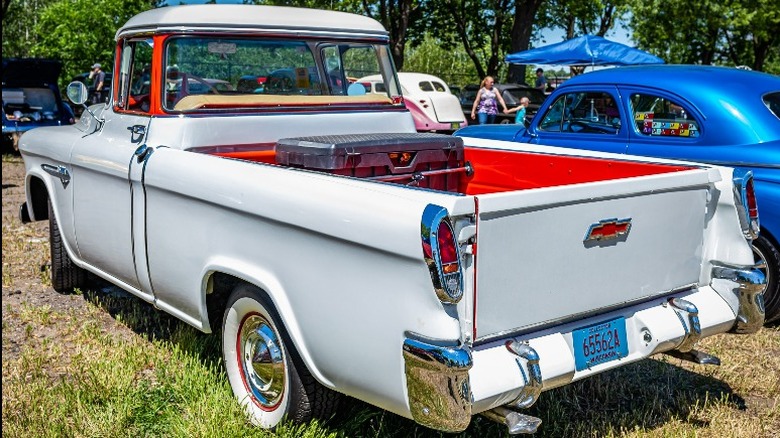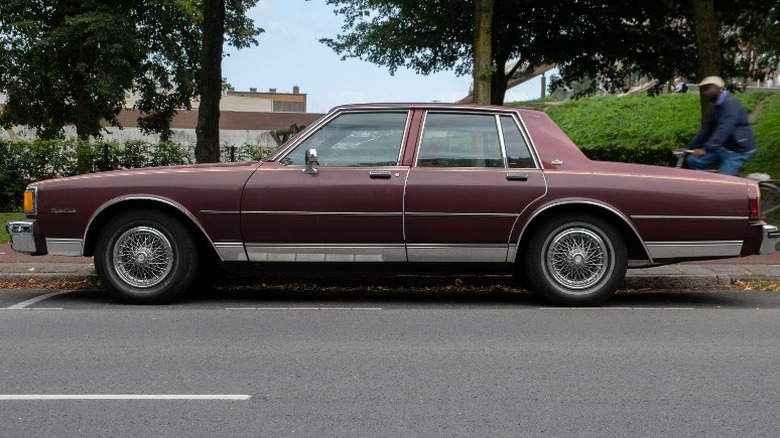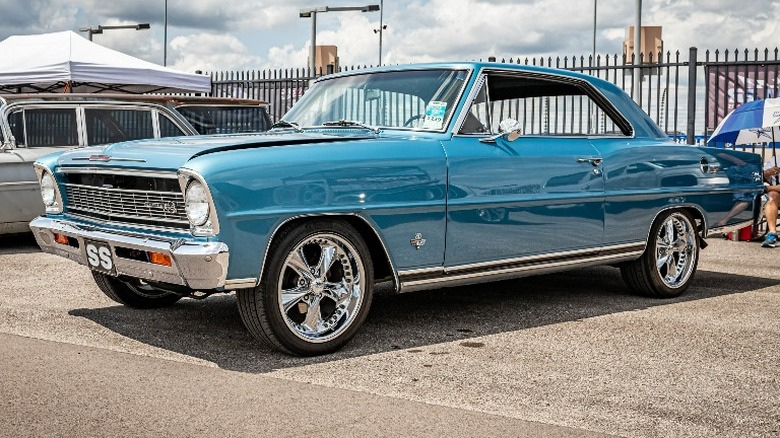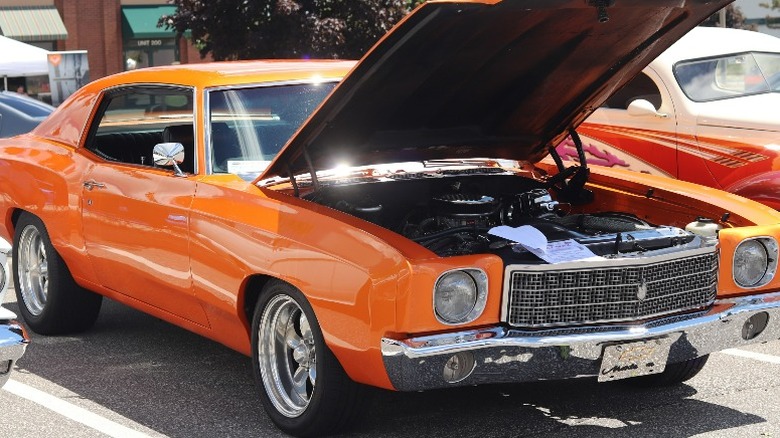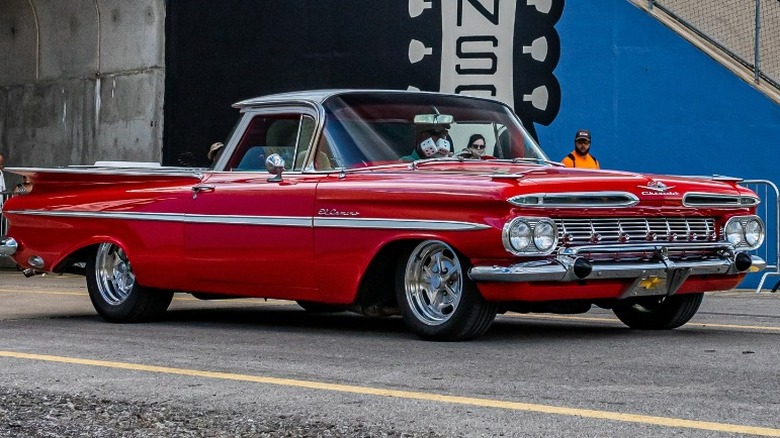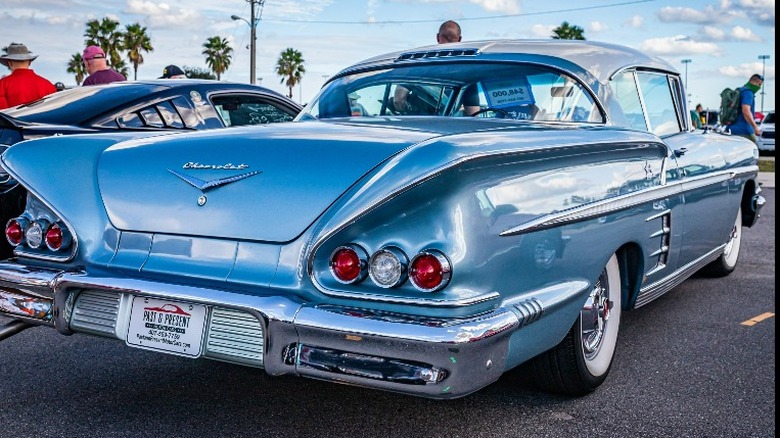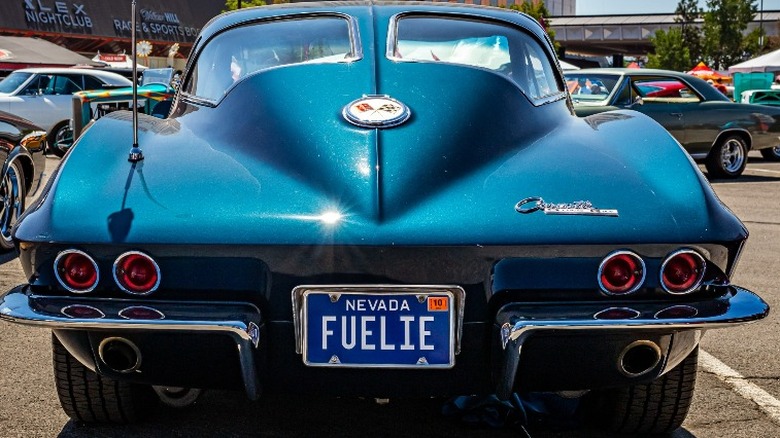10 Classic Chevrolets We Want To Make A Modern Comeback
"Baseball, Hotdogs, Apple Pie and Chevrolet" in the 1970s, and "The Heartbeat of America" featured in commercials from 1987 to 1994, were perhaps the most well-known Chevrolet slogans heard over the years (via Car Directory). These mantras represent an automaker that has produced more than 200 million cars and trucks since it was founded on November 3, 1911 (via All American Made). One of the three largest automakers in the U.S., Chevrolet has had a significant impact on the American (and the world) automobile industry, producing some of the most innovative and recognizable cars and trucks over its long history.
Chevrolet autos have combined attractive designs, performance, and reliability, making icons such as the Camaro, Chevelle, and Corvette essential elements for the development of automobile technology. Many of these have become classics and the obsession of car collectors worldwide. Furthermore, Chevrolet's countless innovations have been adopted by many of its competitors. The automaker built the first fuel-injected engine in 1957 after introducing the small-block V-8 design in 1955, which was continuously produced for more years than any other mass-produced engine in the world. Chevy still makes a V-8 Camaro to compete with Mustang and Challenger.
While not all Chevy models were winners and many have come and gone during the company's long history, some were exceptional in their era and could be extraordinary once again. Here are 10 discontinued classic Chevrolets we would like to make a modern comeback.
Chevrolet Bel Air
Although the Chevrolet Bel Air was produced from 1950 to 1975 for the U.S. market, the 1955-1957 model year cars are considered the line icons. The Bel Air was exceptionally popular with more than 700,000 units built (via Trust Auto), 47,000 of which were convertibles (via General Motors). The stylish tail fins of the 1957 model make it the most recognizable.
Chevrolet offered the Bel Air in seven body styles: convertible, two-door sport sedan, two-door sport hardtop coupe, four-door sedan, two-door sedan, four-door wagon, and two-door, six-passenger Nomad station wagon. The '57 Chevy came in the base 150 trim, the mid-level 210 trim, and the premium Bel Air trim, which boasted superior equipment, the most features, and distinguishing accents.
Typical of most full-size cars of that era, the Bel Air featured a front engine and rear-wheel drive. Early 1950s full-sized Chevys were typically equipped with 3.5- and 3.9-liter inline six-cylinder engines. The '57 Bel Air was initially offered with a 4.3-liter V-8 producing 162 horsepower and later replaced with a 4.6-liter, mated to a 3-speed manual or a 2- or 3-speed automatic transmission (via Auto Trader). Chevrolet also offered the Bel Air with a Super Turbo-Fire V-8 that featured the state-of-the-art Ramjet Fuel Injection system. It was the first GM production V-8 passenger car with a technology that replaced carburetors, resulting in enhanced performance and fuel efficiency.
Chevrolet CK Truck
Chevrolet introduced the C/K Series pickup trucks in 1960 and they quickly became well-known for their technological innovations. The first generation (1960 to 1966) offered a dropped frame that made more room available in the cab and provided a lower cargo loading height. The C/K was the first truck to implement an independent front suspension, introduced nearly five years before Ford announced its "Twin I-Beam" front suspension. The independent suspension made trips in the C/K more comfortable and improved handling over older models built with a straight axle on leaf springs.
The C/K pickup trucks were also the first to offer the groundbreaking GM-designed four-wheel drive. Older model pickups offered it as an option, but it was implemented as a NAPCO (Northwestern Auto Parts Company) conversion. Engine options in 1962 included the 3.9-liter six-cylinder producing 135 horsepower and 216 pound-feet of torque. Chevrolet offered an upgrade to the more robust 4.6-liter V-8 that generated 160 horsepower and 270 pound-feet of torque (via Chevrolet).
The third generation C/K Truck series (beginning in 1973) made significant strides toward achieving better daily driving characteristics. Even though the C/K's square body lacked the slippery low drag coefficient shape of today's vehicles, Chevrolet's extensive wind tunnel testing improved aerodynamics over previous truck bodies (via Coverking). Interior designs included comfortable bench seating and wood-grain adornments with chrome, while the premium models added insulation and tightened cabins to reduce road noise.
Chevrolet Corvair Monza
Designed to compete with the Ford Falcon, Plymouth Valiant, and VW beetle, the Corvair offered several features not found in other American cars. It was GM's first mass-produced unit-body vehicle in the U.S., and the first American postwar car (beating Corvette to the market) implementing front and rear independent suspensions. The Corvair also was the first mass-produced domestic car powered by an air-cooled engine.
Chevrolet fitted the lightweight Monza (curb weight of 2,500 pounds) with a naturally aspirated 144.9 cubic inch Boxer 6-cylinder engine producing 102 bhp at 4400 rpm and 134 lb-ft of torque at 4400 rpm. Power is sent to the rear wheels via a three-speed Manual gearbox (via Ultimate Specs). The 1965 Corvair Monza Spyder offered the best performance and handling of the line with a turbocharged 164 cubic inch engine producing 180 horsepower (via Concept Carz).
Corvair sales in 1960 exceeded 250,000, placing third in the compact car category behind the Ford Falcon and the AMC Rambler. Sales remained strong through 1965 but fell to 103,743 units in 1966 and declined to only 6,000 units in 1969, the last year of production (via Automobile Catalog). The introduction of the Plymouth Barracuda and Ford Mustang sealed the Corvair's fate.
Chevrolet Cameo Carrier Pickup
When Chevrolet introduced the Cameo Carrier Pickup in 1955, the automaker demonstrated that a truck could be more than just a utility vehicle for hauling dirt, raw materials, and tools. The automaker designed the stylish "gentleman's pickup" featuring luxury amenities and comfort features usually found only in premium cars, making it appealing to more buyers. Chevrolet offered the pickup truck with a 235 cubic inch straight-six connected to a three-speed manual. Buyers could opt for a 4.3-liter (265 cubic inch) V-8 producing 145 horsepower mated to a three-speed manual heavy-duty, four-speed manual, three-speed automatic with overdrive, or All-synchro Hydra-Matic transmission (via Concept Carz).
To make the truck appear more elegant, Chevrolet borrowed several external elements from other GM vehicles. The chrome taillights mounted at the trailing end of each fender came from the recently discontinued 1954 Chevrolet Bel Air, and the hubcaps from the 1955 Bel Air were mounted on rims with wide whitewall tires. The automaker painted every Cameo Carrier cab in a Bombay Ivory color and fitted them with a wide wrap-around glass rear window. The bed interior was painted industrial red. While pickup trucks built before the 1950s traditionally came with a basic cab, the 1955 Cameo Carrier offered every available option, including a radio, red and ivory dash, two-tone upholstery, power steering, and even carpeting. GM also employed an innovative design for the truck bed.
Chevrolet Caprice
In mid-1965, Chevrolet introduced the Caprice as a premium trim package for the full-sized Impala four-door hardtop. Chevrolet's first venture into the luxury car market was an immediate success. Full-size Chevrolet sales set records in 1965 with over 1 million sold. The automaker manufactured 40,393 Caprice units during its abbreviated first year, the site "Impalas" notes, and the deluxe trim went on to become the most popular U.S. car during the 1960s and early 1970s. The Caprice won numerous awards through the years including Motor Trend's "Car of the Year" award in both 1977 and 1991.
Chevrolet created the Caprice trim and sold the upgrade for $242.10 to compete with the successful Ford LTD series. While Chevrolet offered several engine options including a 130 cubic inch six-cylinder in the Impala, the Caprice trim was fitted only with one of several available V-8 engines. These included the 250 horsepower 327 cid, 300 horsepower 327 cid, 325 horsepower 396 cid, 340 horsepower 409 cid, and the top-end 400 horsepower 409 cid engine with 4-barrel carburetor and dual exhaust (via Chevy Options).
Chevy Nova SS
When Chevrolet introduced the compact four-cylinder conventional X-body Chevy II in 1962 to compete with the successful 1960 Ford Falcon, the automaker also launched a higher-performance model, the Chevy II Nova 400 (via Concept Carz). The Nova featured a 194-cubic-inch straight-six that produced 120 horsepower. However, in 1964, the Nova began to take on the characteristics of a muscle car, albeit one in "sheep's clothing." Chevrolet offered the compact car weighing only 2,500 pounds with factory-installed 195 and 220 horsepower 283 small block engines.
In 1965, more horsepower was added with the 327-cubic-inch option producing 250 horsepower (L30) and 300 horsepower (L74), respectively. Mated to the close-ratio four-speed, the Nova accelerated to 60 mph in a blistering (for the era) 6.3 seconds, to 100 mph in 18.7 seconds, and reached the quarter mile in 15 seconds (via Automobile Catalog). Chevrolet added new features such as the in-dash tachometer, FM band radio, and the twelve-bolt Posi rear end.
The Super Sport package that was carried over from previous years gave the Nova an appearance that rivaled other muscle cars. It added bucket seats, a center console, and a floor shift as well as badges and minor external touches to distinguish the model from the standard Nova. The restyled 1966 Nova SS is considered by many enthusiasts the most desirable of the brand. Chevrolet offered several engine options, but the best performing variant was the L79 version of the 327 cubic inch engine: the "Mighty Mouse."
Chevrolet Monte Carlo
The original Monte Carlo had a short lifespan. Chevrolet introduced the luxury muscle car in 1970 to compete with the Pontiac Grand Prix and Buick Riviera but the 1970 energy crisis doomed the first-generation high-performance car to just three production years. In the early '70s, the emerging luxury car segment was characterized by long hoods, two doors, and a short trunk. Although priced below many competitors such as the Oldsmobile Toronado and Ford Thunderbird, both the Grand Prix and the Monte Carlo qualified as low-end entries to the extravagant segment.
While the two-door Monte Carlo and the Chevrolet Chevelle shared many components, including the trunk lid, rear window, windshield, and firewall, the former sat on a much longer wheelbase. The Monte Carlo needed a 116 inches wheelbase to support the long hood compared to the Chevelle's 112-inch wheelbase. The luxury muscle car boasted the longest hood in the history of Chevrolet.
The Monte Carlo came standard with a 350-cubic-inch V-8 fed by a two-barrel carburetor mated to a three-speed manual transmission. Chevrolet also offered an optional four-speed manual and two- and -three-speed automatics. Buyers could upgrade to a 400 cubic inch V-8 or the massive 454 cubic inch mill generating 360 horsepower and 500 lb-ft of torque. The luxury-muscle car accelerated to 60 mph in 7.7 seconds and reached the quarter mile in 16.2 seconds at 90 mph (via Engine Factory).
Chevrolet El Camino
Introduced in 1959, the Chevrolet El Camino was one of the first hybrid vehicles in automotive history (via U.S. News). Produced from 1959 to 1960 and 1964 to 1987, Chevrolet built the utility coupe by adding a cargo bed to a standard two-door Chevrolet station wagon. The combination of car and truck offered buyers the practicality of a pickup truck with the performance and comfort of a car. Chevrolet built five generations of the El Camino, but it is best known for the third generation (1968-1972) when the car/truck became a Chevy muscle car icon. By the third generation, the El Camino had evolved into a more aggressive-looking vehicle and the SS396 model demonstrated that Chevy viewed the unique vehicle as a performance machine as well as a means of hauling cargo.
Chevrolet offered a 3.8-liter and 4.1-liter inline-six and five V-8 options, ranging from the 5.0-liter to two legendary 7.4-liter (454 cubic inches) powerplants. The smaller of the two big-block engines produced 360 horsepower while the more powerful 7.4-liter, Chevrolet's most powerful engine available at the time, produced 450 horsepower and 500 lb-ft of torque (via Ray Buck). The El Camino came with a three- and four-speed manual or a two- and three-speed automatic. The automaker manufactured nearly 237,000 units during the third generation's five model years (via Autotrader Classics). While the El Camino is not known for its exceptional performance its unique silhouette makes it one of the most recognizable cars on the road.
Chevrolet Impala
The Chevrolet Impala brand began as a full-size sedan but saw many changes during nearly six decades of production including model years 1958-1985, 1994-1996, and 2000-2020. The Chevy flagship passenger car ranked among the best-selling American cars in the U.S. with more than 13 million units sold during its production years (via Hagerty).
In the 1960s, the automobile industry was going through a change. Full-size cars were losing favor with younger buyers who preferred sporty intermediates and the growing pony-car segment led by the Ford Mustang. Other factors also influenced the transition including government regulations for safer autos and mandates for cleaner emissions. The '64 Impala represented the last hurrah of the long sleek Chevys, but sales remained strong and even improved over the previous year. Chevrolet Impala sales increased from 832,000 in '63 to an impressive 890,000 in '64. The automaker sold more than 185,000 Impala Super Sports in '64, an increase of 35,000 units over the '63 sales (via Hemmings).
The Sport Sedan is the best-known Impala, fitted with a 409 cubic inch V-8 Turbo-Fire producing 425 horsepower connected to a four-speed manual transmission. The car, measuring 210 inches long (nearly the same length as a modern-day Chevy Suburban) accelerates from 0 to 60 mph in 6.2 seconds and reaches the quarter mile time in 14.7 seconds (via Automobile Catalog).
Chevrolet Corvette C2
Although the Corvette is still in production, the second generation C2 was discontinued in 1967 after five production years. The model we would like to see make a return is the 1963 Corvette StingRay with its elegantly sculpted lines and 327-cubic inch V-8 engine. It was the only model year in Corvette's history to feature a split-window design.
Although Chevrolet introduced the 1963 Corvette with a new and unique rear-window design, the automaker kept the same engine used in the previous year's model (via Corvette Story). The 327-cubic-inch standard engine produced 250 horsepower, but Chevy also offered the 300-horsepower (L75) and 340-horsepower (L76) engines. At the top end, the fuel-injected L84 produced 360 horsepower. The 340 horsepower-equipped "Vette" with a three-speed manual accelerates to 60 mph in 5.6 seconds, 0-100 km/h in 6.2 seconds, and reaches the quarter mile in 14.3 seconds (via Automobile Catalog).
When introduced, the StingRay was well-received by buyers for its state-of-the-art engineering, excellent performance, and refined styling. Today, the split window configuration makes it a collector's dream. However, at launch, the unique rear window was not favored by the public. Potential buyers expressed concern that the center pillar blocked rearward visibility. In some circumstances, owners removed the two glass window planes and replaced them with a single piece. At the time, some Chevy dealerships even offered to change out the window. The following year Chevrolet offered the StingRay with a single piece of glass only (via Corv Port).
